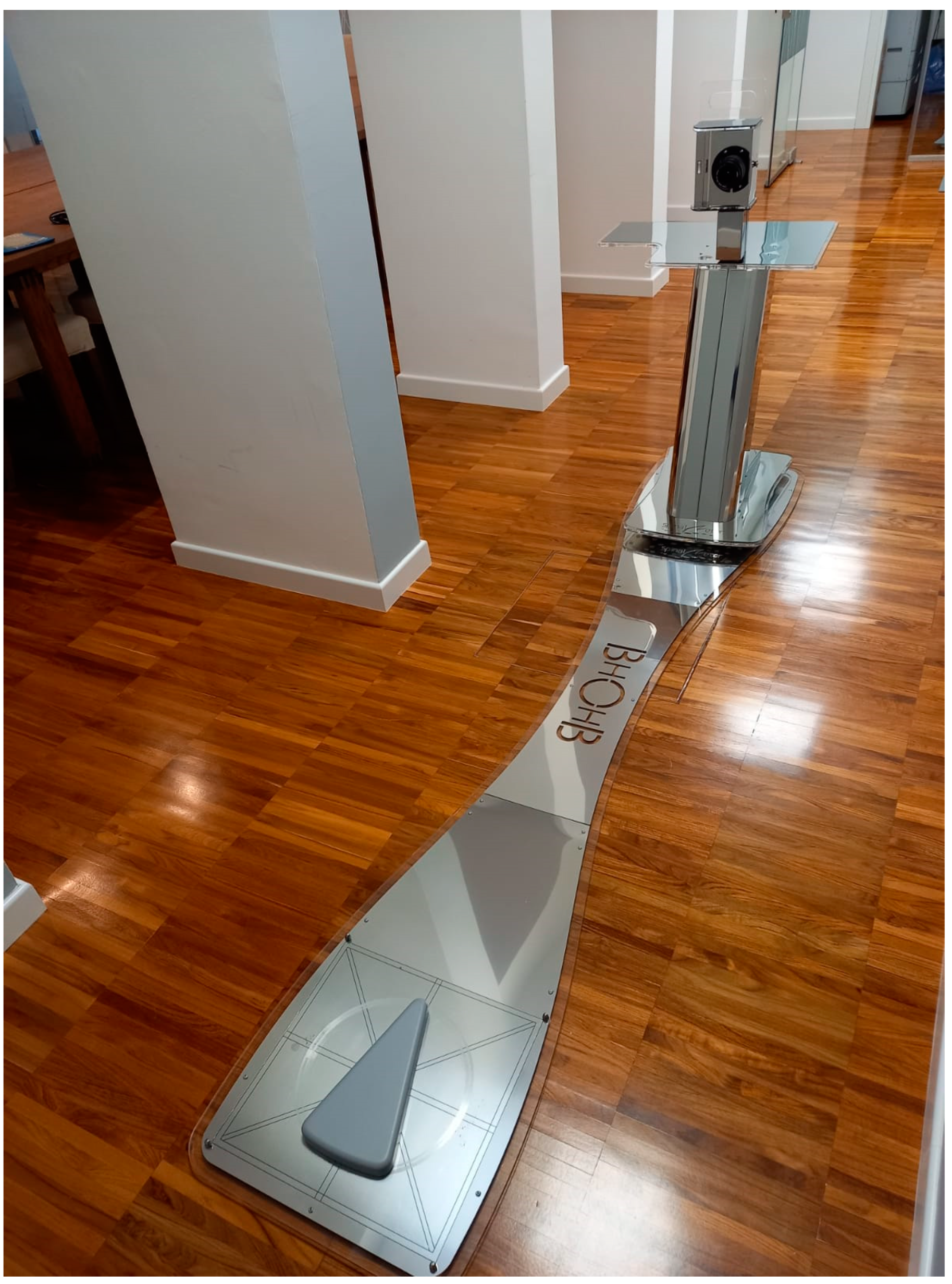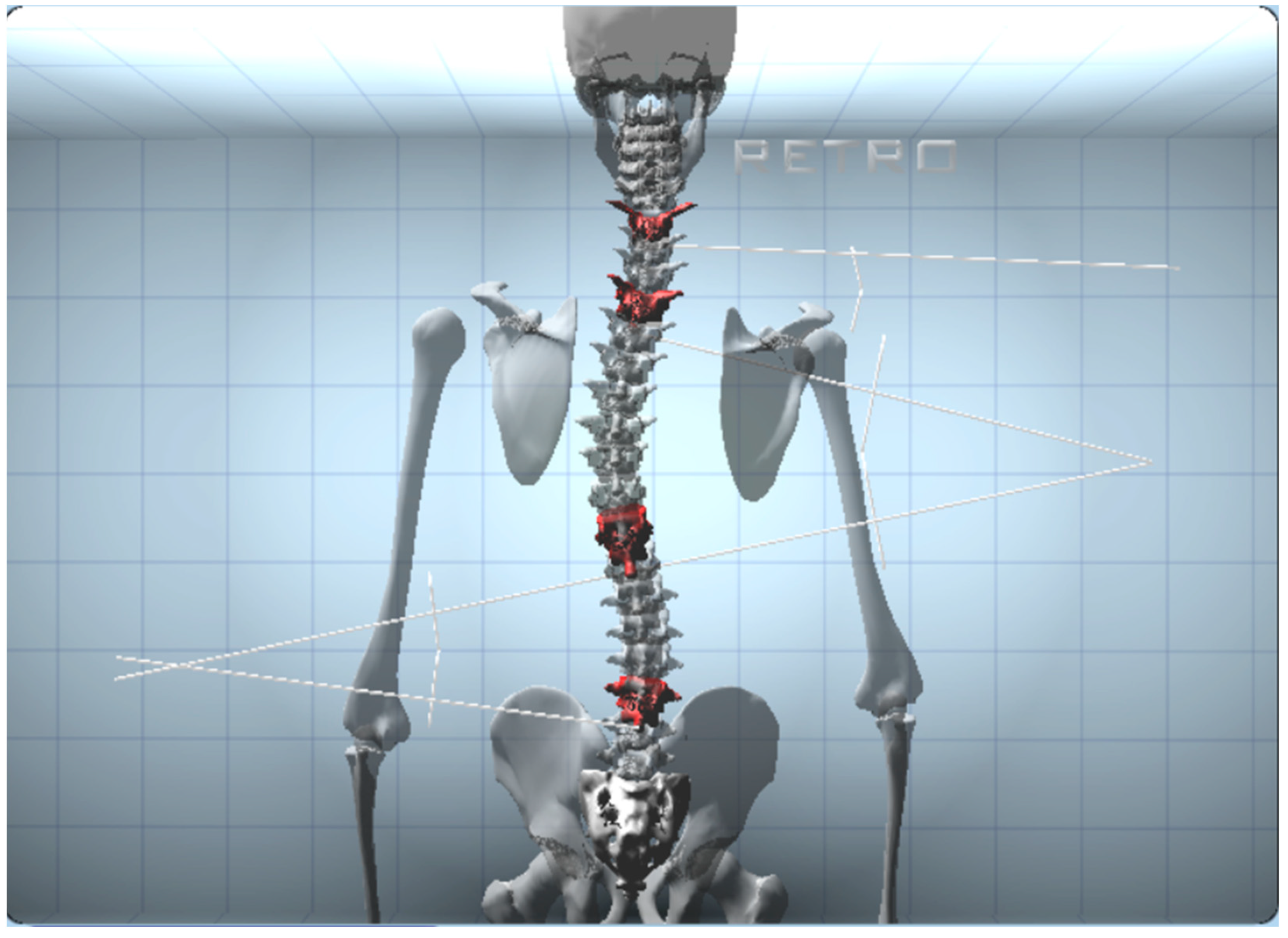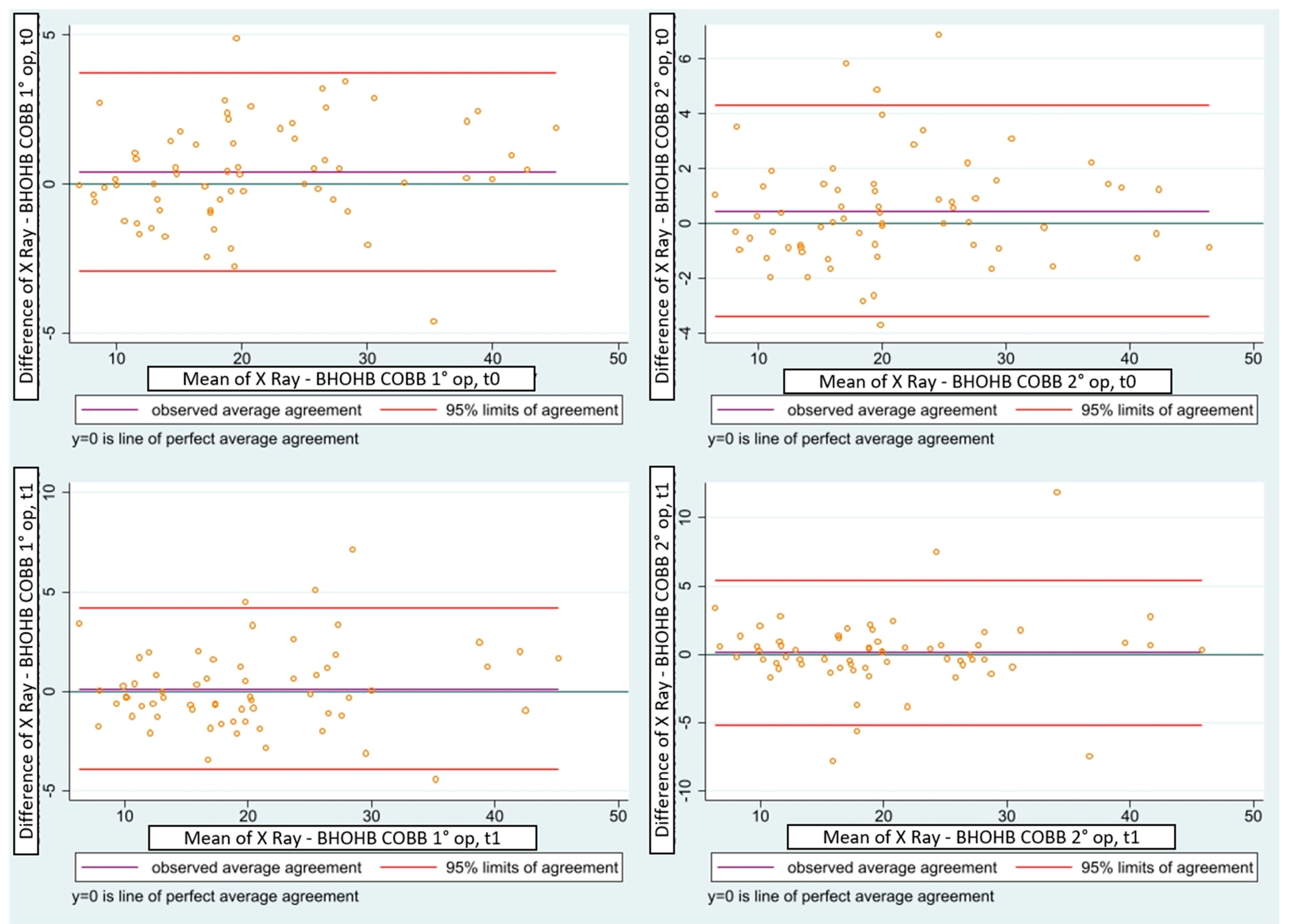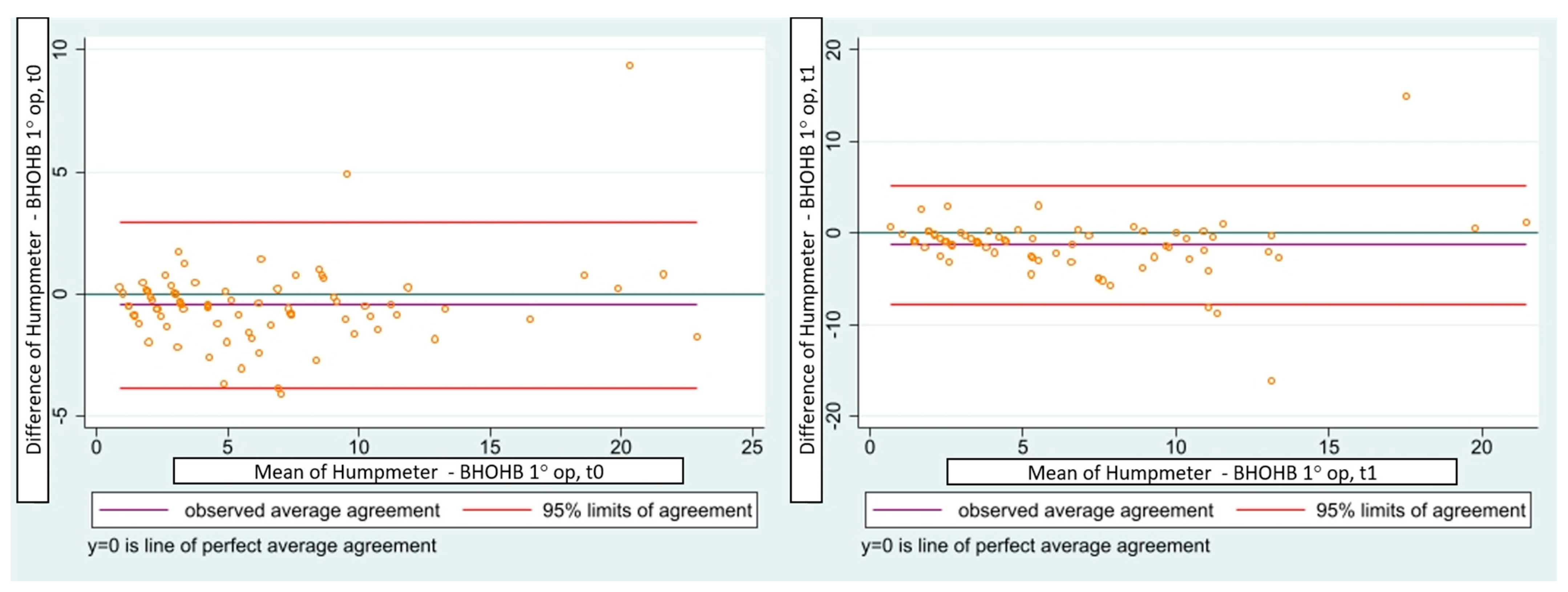Is Surface Topography Useful in the Diagnosis of Scoliosis? Validation of the Biometrical Holistic of Human Body (BHOHB)
Abstract
:1. Introduction
2. Materials and Methods
2.1. Study Design
2.2. Setting and Population
2.2.1. Inclusion Criteria
- -
- Age between 10 and 16 years old;
- -
- Orthostatic radiography of the spine in 2 standard projections, for diagnostic purposes, at least 60 days before the first exam;
- -
- Idiopathic scoliosis with a Cobb angle >10°;
- -
- Positive Adams test;
- -
- No prior conservative brace treatment.
2.2.2. Exclusion Criteria
- -
- Scoliosis secondary to other illnesses (neuromuscular, congenital, neoplastic, osteochondrodystrophic);
- -
- Spine X-ray taken more than 60 days after study start;
- -
- Previous spinal surgery;
- -
- Adams test negative with curves <10°;
- -
- Patients with a BMI (Body Mass Index) higher than 25.0 kg/m2.
2.3. Protocol Examination
- C7 vertebral spinous process;
- Left acromion;
- Right acromion;
- Left inferior scapulae angle;
- Right inferior scapulae angle;
- Interscapular vertebral spinous process located midway between the left and right inferior scapular angles;
- Vertebral spinous process located midway between points 1 and 6;
- Left posterior superior iliac spine;
- Right posterior superior iliac spine;
- Pelvic shelf (usually L5);
- Vertebral spinous process located midway between points 6 and 10.
2.4. Potential Bias
2.5. Statistical Assessment
2.5.1. Dimension of Sample
2.5.2. Statistic Plane
- 0.25–0.50: poor correlation;
- 0.50–0.75: moderate to good correlation;
- 0.75–1.00: very good to excellent correlation.
3. Results
4. Discussion
5. Conclusions
Author Contributions
Funding
Institutional Review Board Statement
Informed Consent Statement
Data Availability Statement
Conflicts of Interest
References
- Negrini, S.; Donzelli, S.; Aulisa, A.G.; Czaprowski, D.; Schreiber, S.; de Mauroy, J.C.; Diers, H.; Grivas, T.B.; Knott, P.; Kotwicki, T.; et al. 2016 SOSORT guidelines: Orthopaedic and rehabilitation treatment of idiopathic scoliosis during growth. Scoliosis Spinal Disord. 2018, 13, 3. [Google Scholar] [CrossRef]
- Burwell, R.G.; James, N.J.; Johnson, F.; Webb, J.K.; Wilson, Y.G. Standardised trunk asymmetry scores. A study of back contour in healthy school children. J. Bone Joint Surg. Br. 1983, 65, 452–463. [Google Scholar] [CrossRef] [PubMed]
- Brooks, H.L.; Azen, S.P.; Gerberg, E.; Brooks, R.; Chan, L. Scoliosis: A prospective epidemiological study. J Bone Joint Surg Am. 1975, 57, 968–972. [Google Scholar] [CrossRef] [PubMed]
- Wong, H.-K.; Hui, J.H.P.; Rajan, U.; Chia, H. Idiopathic scoliosis in Singapore schoolchildren: A prevalence study 15 years into the screening program. Spine 2005, 30, 1188–1196. [Google Scholar] [CrossRef]
- Grivas, T.B.; Vasiliadis, E.; Mouzakis, V.; Mihas, C.; Koufopoulos, G. Association between adolescent idiopathic scoliosis prevalence and age at menarche in different geographic latitudes. Scoliosis 2006, 1, 9. [Google Scholar] [CrossRef] [PubMed]
- Dickson, R.A. Scoliosis in the community. Br. Med. J. Clin. Res. Ed. 1983, 286, 1745. [Google Scholar] [CrossRef] [PubMed]
- Soucacos, P.N.; Soucacos, P.K.; Zacharis, K.C.; Beris, A.E.; Xenakis, T.A.; Ioannina, G. Schoolscreening for scoliosis. A prospective epidemiological study in northwestern and central Greece. J. Bone Joint Surg. Am. 1997, 79, 1498–1503. [Google Scholar] [CrossRef] [PubMed]
- Pin, L.H.; Mo, L.Y.; Lin, L.; Hua, L.K.; Hui, H.P.; Hui, D.S.; Chang, B.D.; Chang, Y.Y.; Yuan, L. Early diagnosis of scoliosis based on school-screening. J. Bone Joint Surg. Am. 1985, 67, 1202–1205. [Google Scholar] [CrossRef]
- Huang, S.C. Cut-off point of the Scoliometer in school scoliosis screening. Spine 1997, 22, 1985–1989. [Google Scholar] [CrossRef]
- Nissinen, M.; Heliövaara, M.; Ylikoski, M.; Poussa, M. Trunk asymmetry and screening for scoliosis: A longitudinal cohort study of pubertal schoolchildren. Acta Paediatr. Oslo Nor. 1993, 82, 77–82. [Google Scholar] [CrossRef]
- Willner, S.; Udén, A. A prospective prevalence study of scoliosis in Southern Sweden. Acta Orthop. Scand. 1982, 53, 233–237. [Google Scholar] [CrossRef]
- Laulund, T.; Søjbjerg, J.O.; Hørlyck, E. Moiré topography in school screening forstructural scoliosis. Acta Orthop. Scand. 1982, 53, 765–768. [Google Scholar] [CrossRef] [PubMed]
- Morais, T.; Bernier, M.; Turcotte, F. Age- and sex-specific prevalence of scoliosis and the value of school screening programs. Am. J. Public Health 1985, 75, 1377–1380. [Google Scholar] [CrossRef] [PubMed]
- Yawn, B.; Yawn, R.A. Efficacy of school scoliosis screening. Orthopedics 2001, 24, 317. [Google Scholar] [CrossRef] [PubMed]
- Gore, D.R.; Passehl, R.; Sepic, S.; Dalton, A. Scoliosis screening: Results of a community project. Pediatrics 1981, 67, 196–200. [Google Scholar] [CrossRef]
- Rogala, E.J.; Drummond, D.S.; Gurr, J. Scoliosis: Incidence and natural history. A prospective epidemiological study. J. Bone Joint Surg. Am. 1978, 60, 173–176. [Google Scholar] [CrossRef]
- Shands, A.R.; Eisberg, H.B. The incidence of scoliosis in the state of Delaware; a study of 50,000 minifilms of the chest made during a survey for tuberculosis. J. Bone Joint Surg. Am. 1955, 37, 1243–1249. [Google Scholar] [CrossRef]
- Koukourakis, I.; Giaourakis, G.; Kouvidis, G.; Kivernitakis, E.; Blazos, J.; Koukourakis, M. Screening school children for scoliosis on the island of Crete. J. Spinal. Disord. 1997, 10, 527–531. [Google Scholar] [CrossRef]
- Grivas, T.B.; Wade, M.H.; Negrini, S.; O’Brien, J.P.; Maruyama, T.; Hawes, M.C.; Rigo, M.; Weiss, H.R.; Kotwicki, T.; Vasiliadis, E.S.; et al. SOSORT consensus paper: School screening for scoliosis. Where are we today? Scoliosis 2007, 2, 17. [Google Scholar] [CrossRef]
- Cobb, J. Outline for the study of scoliosis. Am. Acad. Orthop. Surg. Instr. Course Lect. 1948, 5, 261–275. [Google Scholar]
- Aulisa, A.G.; Guzzanti, V.; Galli, M.; Bottaro, G.; Vitelli, O.; Ferrara, P.; Logroscino, G. The familiarity of idiopathic scoliosis: Statistical analysis and clinical considerations. Eur. J. Orthop. Surg. Traumatol. 2013, 23, 781–784. [Google Scholar] [CrossRef] [PubMed]
- Asher, M.A.; Burton, D.C. Adolescent idiopathic scoliosis: Natural history and long term treatment effects. Scoliosis 2006, 1, 2. [Google Scholar] [CrossRef] [PubMed]
- Ronckers, C.M.; Land, C.E.; Miller, J.; Stovall, M.; Lonstein, J.E.; Michele, M.D. Cancer mortality among women frequently exposed to radiographic exams for spinal disorders. Radiat. Res. 2010, 174, 83–90. [Google Scholar] [CrossRef]
- Lowe, D.; Roy, L.; Tabocchini, M.A.; Rühm, W.; Wakeford, R.; Woloschak, G.E.; Laurier, D. Radiation dose rate effects: What is new and what is needed? Radiat. Environ. Biophys. 2022, 61, 507–543. [Google Scholar] [CrossRef] [PubMed]
- The 2007 Recommendations of the International Commission on Radiological Protection; ICRP publication 103; Elsevier: Amsterdam, The Netherlands, 2007; Volume 37, pp. 1–332.
- Turner-Smith, A.R. A television/computer three-dimensional surface shape measurement system. J. Biomech. 1988, 21, 515–529. [Google Scholar] [CrossRef] [PubMed]
- Berryman, F.; Pynsent, P.; Fairbank, J.; Disney, S. A new system for measuring threedimensional back shape in scoliosis. Eur. Spine J. 2008, 17, 663–672. [Google Scholar] [CrossRef] [PubMed]
- Guidetti, L.; Bonavolonta, V.; Tito, A.; Reis, V.M.; Gallotta, M.C.; Baldari, C. Intra- and interday reliability of spine raterstereography. Biomed. Res. Int. 2013, 2013, 745480. [Google Scholar] [CrossRef]
- Knott, P.; Mardjetko, S.; Nance, D.; Dunn, M. Electromagnetic topographical technique of curve evaluation for adolescent idiopathic scoliosis. Spine 2006, 31, E911–E915. [Google Scholar] [CrossRef]
- Shannon, T.M. Development of an apparatus to evaluate adolescent idiopathic scoliosis by dynamic surface topography. Stud. Health Technol. Inform. 2008, 140, 121–127. [Google Scholar]
- Zheng, Y.-P.; Lee, T.T.-Y.; Lai, K.K.-L.; Yip, B.H.-K.; Zhou, G.-Q.; Jiang, W.-W.; Cheung, J.C.-W.; Wong, M.-S.; Ng, B.K.-W.; Cheng, J.C.-Y.; et al. A reliability and validity study for Scolioscan: A radiationfree scoliosis assessment system using 3D ultrasound imaging. Scoliosis Spinal. Disord. 2016, 11, 13. [Google Scholar] [CrossRef]
- Wang, Q.; Li, M.; Lou, E.H. Reliability and Validity Study of Clinical Ultrasound Imaging on Lateral Curvature of Adolescent Idiopathic Scoliosis. PLoS ONE 2015, 10, e0135264. [Google Scholar] [CrossRef] [PubMed]
- Goh, S.; Price, R.I.; Leedman, P.J.; Singer, K.P. Rasterstereographic analysis of the thoracic sagittal curvature: A reliability study. J. Musculoskelet. Res. 1999, 3, 137–142. [Google Scholar] [CrossRef]
- Labecka, M.K.; Plandowska, M. Moire topography as a screening and diagnostic tool-A systematic review. PLoS ONE 2021, 16, e0260858. [Google Scholar] [CrossRef]
- Su, X.; Dong, R.; Wen, Z.; Liu, Y. Reliability and Validity of Scoliosis Measurements Obtained with Surface Topography Techniques: A Systematic Review. J. Clin. Med. 2022, 11, 6998. [Google Scholar] [CrossRef] [PubMed]
- Aulisa, A.G.; Guzzanti, V.; Perisano, C.; Marzetti, E.; Menghi, A.; Giordano, M.; Aulisa, L. Correlation Between Hump Dimensions and Curve Severity in Idiopathic Scoliosis Before and After Conservative Treatment. Spine 2018, 43, 114–119. [Google Scholar] [CrossRef] [PubMed]







| LIN Concordance Correlation Coefficient (p-Value) | Pearson Correlation Coefficient (p-Value) | |
|---|---|---|
| X-ray-BHOHB COBB 1° op, t0 | 0.971 (<0.001) | 0.972 (<0.001) |
| X-ray-BHOHB COBB 2° op, t0 | 0.945 (<0.001) | 0.955 (<0.001) |
| X-ray-BHOHB COBB2 1° op, t1 | 0.886 (<0.001) | 0.903 (<0.001) |
| X-ray-BHOHB COBB2 2° op, t1 | 0.907 (<0.001) | 0.927 (<0.001) |
| Humpmeter-BHOHB 1° op, t0 | 0.939 (<0.001) | 0.945 (<0.001) |
| Humpmeter-BHOHB 1° op, t1 | 0.734 (<0.001) | 0.762 (<0.001) |
| Reliability Intraoperator | Intraclass Correlation Coefficient (ICC) | Pearson Correlation Coefficient (p-Value) |
|---|---|---|
| t0–1st op | 0.986 (<0.001) | 0.973 (<0.001) |
| t1–1st op | 0.935 (<0.001) | 0.884 (<0.001) |
| t0–2nd op | 0.976 (<0.001) | 0.954 (<0.001) |
| t1–2nd op | 0.970 (<0.001) | 0.943 (<0.001) |
| Reliability interoperator | ||
| t0: 1st op–2nd op | 0.990 (<0.001) | 0.980 (<0.001) |
| t1: 1st op–2nd op | 0.980 (<0.001) | 0.962 (<0.001) |
Disclaimer/Publisher’s Note: The statements, opinions and data contained in all publications are solely those of the individual author(s) and contributor(s) and not of MDPI and/or the editor(s). MDPI and/or the editor(s) disclaim responsibility for any injury to people or property resulting from any ideas, methods, instructions or products referred to in the content. |
© 2023 by the authors. Licensee MDPI, Basel, Switzerland. This article is an open access article distributed under the terms and conditions of the Creative Commons Attribution (CC BY) license (https://creativecommons.org/licenses/by/4.0/).
Share and Cite
Aulisa, A.G.; Bandinelli, D.; Marsiolo, M.; Falciglia, F.; Giordano, M.; Toniolo, R.M. Is Surface Topography Useful in the Diagnosis of Scoliosis? Validation of the Biometrical Holistic of Human Body (BHOHB). Children 2023, 10, 320. https://doi.org/10.3390/children10020320
Aulisa AG, Bandinelli D, Marsiolo M, Falciglia F, Giordano M, Toniolo RM. Is Surface Topography Useful in the Diagnosis of Scoliosis? Validation of the Biometrical Holistic of Human Body (BHOHB). Children. 2023; 10(2):320. https://doi.org/10.3390/children10020320
Chicago/Turabian StyleAulisa, Angelo G., Diletta Bandinelli, Martina Marsiolo, Francesco Falciglia, Marco Giordano, and Renato M. Toniolo. 2023. "Is Surface Topography Useful in the Diagnosis of Scoliosis? Validation of the Biometrical Holistic of Human Body (BHOHB)" Children 10, no. 2: 320. https://doi.org/10.3390/children10020320
APA StyleAulisa, A. G., Bandinelli, D., Marsiolo, M., Falciglia, F., Giordano, M., & Toniolo, R. M. (2023). Is Surface Topography Useful in the Diagnosis of Scoliosis? Validation of the Biometrical Holistic of Human Body (BHOHB). Children, 10(2), 320. https://doi.org/10.3390/children10020320






